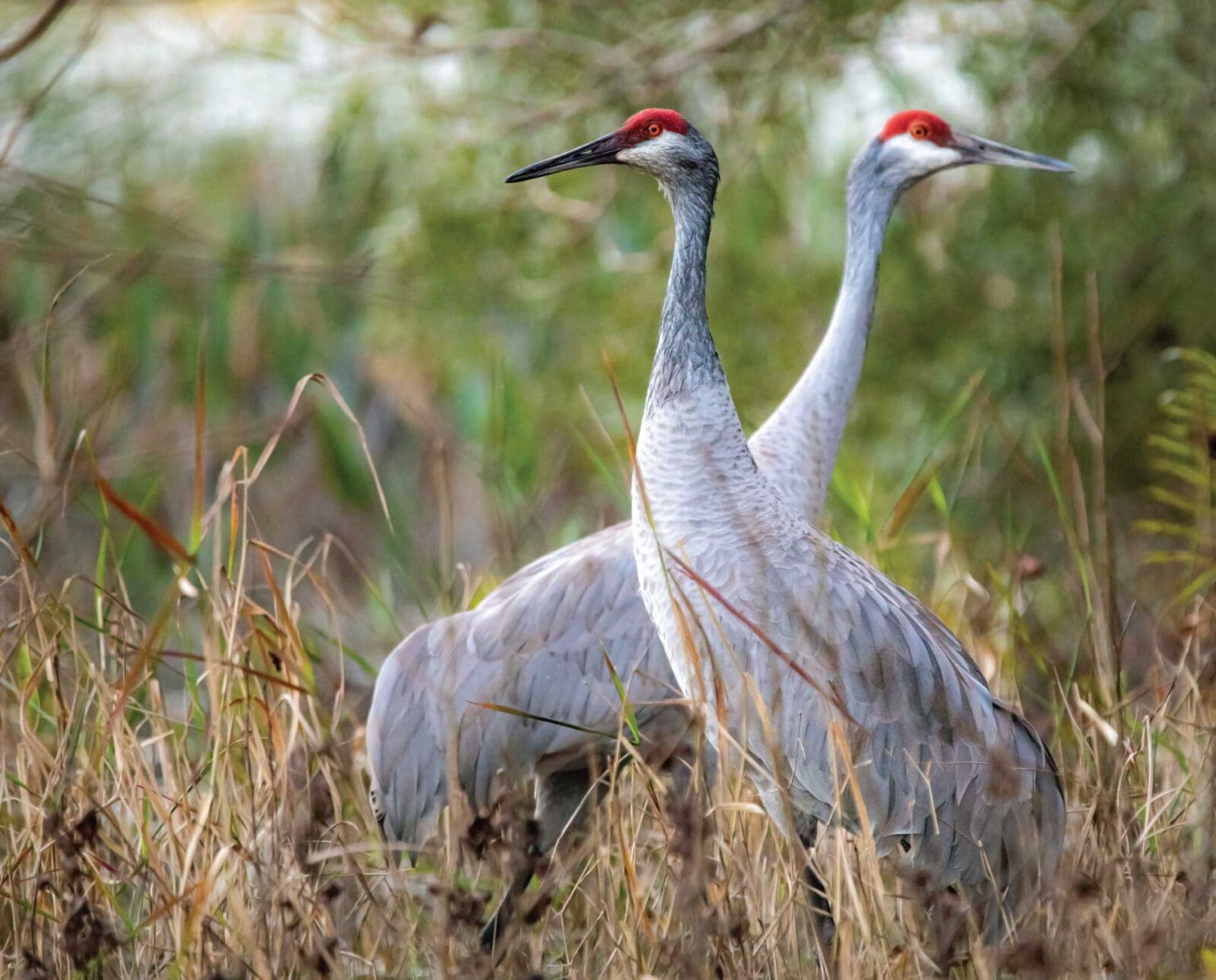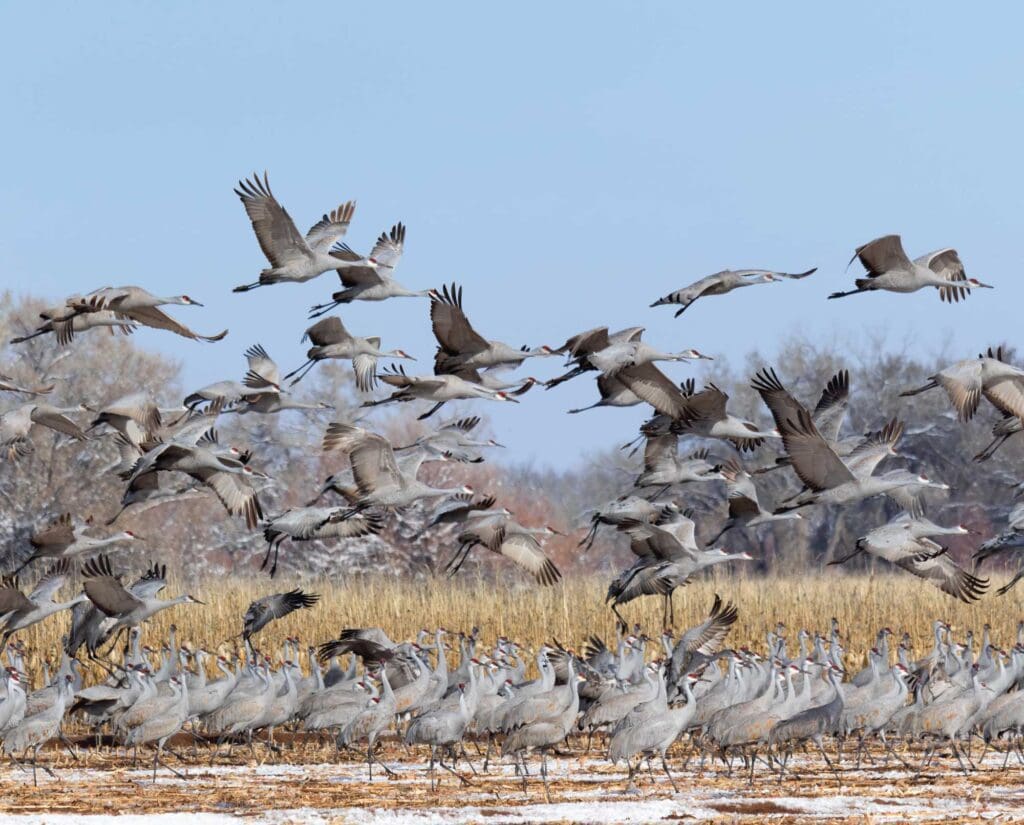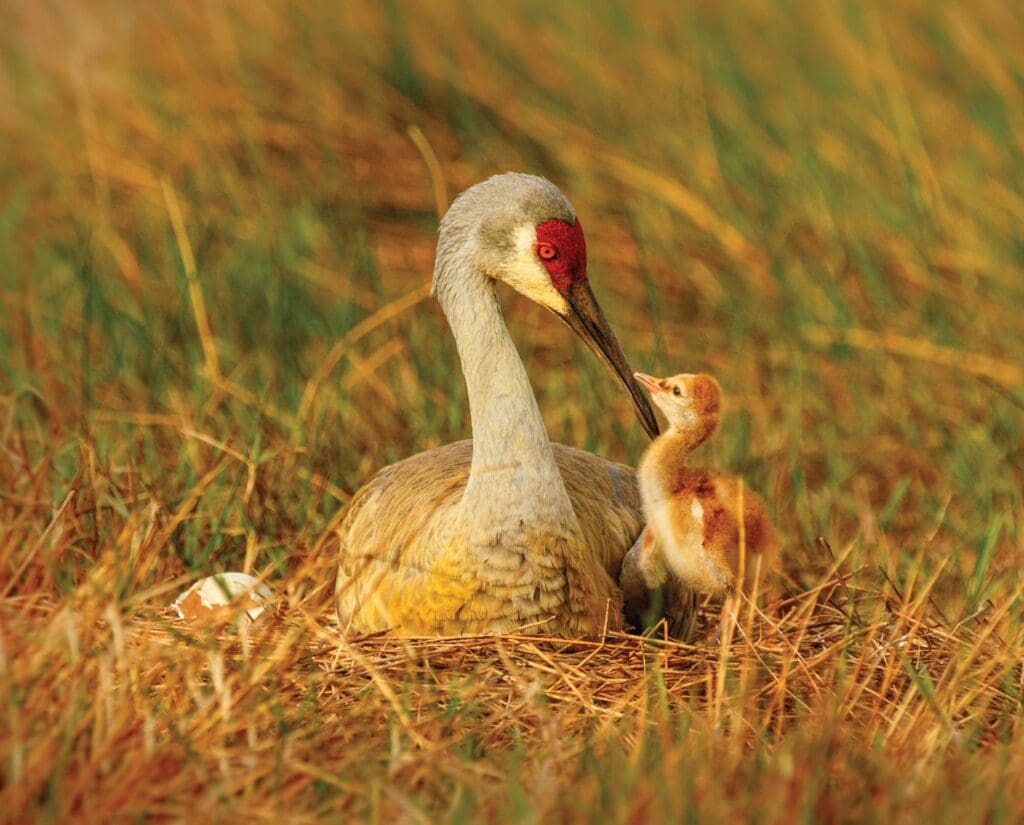Home » Waterfowl Hunting » The Sandhill Crane: Habitat, Life History, and Hunting
The Sandhill Crane: Habitat, Life History, and Hunting
- Climate Change Impact (Audubon) | +1.5°C - 24% Range Lost | +3.0°C - 37% Range Lost

Gabby Zaldumbide is Project Upland's Editor in Chief. Gabby was…
Whether they’re considered an upland bird or waterfowl, sandhill cranes are an emblem of North American conservation successes
Raspy trumpets descending from the heavens broke the crisp silence and broke me out of my ice fishing trance. It’s easy to lose yourself while staring into the flashing circles and lines of a Vexilar screen, but the first sandhill crane calls of the year would snap anyone back into reality. I looked up through my copper-tinted glasses and counted nearly 200 cranes flying west over Blue Mesa Reservoir towards Montrose’s agricultural fields and milder temperatures. That’s more cranes than were left in Wisconsin in the 1930s.
Listen to more articles on Apple | Google | Spotify | Audible
Sandhill cranes (Antigone canadensis) are one of North America’s great conservation successes. This enormous bird species was extirpated from many states within its home range almost a century ago. Today, they can be found across the entire North American continent and into Siberia. Amazingly, in 2019, the U.S. Fish and Wildlife Service estimated their population to be 945,996 cranes. They’re the most abundant crane species in the world. Between 1966 and 2019, their populations have been increasing about four percent annually, according to the North American Breeding Bird Survey. Additionally, Partners in Flight estimates there are 560,000 breeding birds.
Whether one considers them more of an upland bird species, waterfowl species, or something else entirely is still in the air. But however hunters may classify them, these red-crowned birds are becoming legal to pursue across the US.

A Brief History of Sandhill Crane Conservation
Cranes are some of the oldest bird species on Earth. Fossils from the Eocene revealed that cranes were present on our planet over 50 million years ago. According to the Audubon Society, “A Crowned Crane fossil, a close relative of the Sandhill Crane, was found in the Ashfall Fossil Beds in northeast Nebraska, estimated to be about 10 million years old.” The earliest sandhill crane fossil, found in the Macasphalt Shell Pit in Florida, dates back to 2.5 million years ago. Other sandhill fossils, like one found in Nebraska, support the narrative that sandhills are “one of the oldest known bird species” (International Crane Foundation). Cranes are unarguably an iconic species for our entire planet.
Fast forward to the 1800s and 1900s, and market hunters nearly drove this ancient species to extinction. Sandhills were extirpated from most of their home range, including most states east of the Mississippi River. In addition to being overhunted, increased human development eliminated suitable crane habitat across the US. The reduction in suitable habitat and population size contributed to their population declining to an estimated several thousand individuals by 1940.
Captive breeding programs and translocating live-trapped birds helped wild sandhill crane populations rebound through the second half of the 20th century. Although the Cuban and Mississippi sandhill crane subspecies are still listed as endangered under the Endangered Species Act, the lesser, Florida, and greater subspecies are rebounding.
Sandhill Crane Classifications
Sandhill cranes are found in the family Gruidae within the order Gruiformes. Their closest relatives are the other 14 species of cranes found in their family, and rails, coots, and gallinules are their Gruiformes cousins. There are six subspecies of sandhill crane:
- Lesser sandhill crane, A. c. canadensis
- Greater sandhill crane, A. c. tabida
- Canadian Sandhill Crane, A. c. Rowani
- Florida sandhill crane, A. c. pratensis
- Cuban sandhill crane, A. c. nesiotes (endangered)
- Mississippi sandhill crane, A. c. pulla (endangered)
Interestingly, the greater, lesser, and Canadian subspecies are migratory, while the Cuban, Mississippi, and Florida subspecies are year-round residents within their home ranges.
Previously classified under the genus Grus, sandhills were reclassified to the genus Antigone in 2016. When the reclassification went public, the American Birding Association mentioned, “Antigone is the name of Oedipus’s daughter/half-sister in Greek mythology.” It’s understood that Antigone is known for her unwavering beliefs, and her name means “in place of one’s parents.”

Sandhill Crane Life History
These tall, long-necked birds are not a sexually dimorphic species; both male and female sandhills look alike. They are covered in brown-tipped, heavy-looking gray body feathers and red crowns and white throats adorn their heads. However, immature birds have very little to no red on their heads and have rust-colored necks. All birds have thick black bills and long black legs. Lesser sandhills stand around three to four feet tall and weigh around 7.5 pounds. Greater sandhills can be four to five feet tall and weigh nine to twelve pounds.
Sandhill cranes mate for life and stay together year-round. This helps increase the survival rates of their offspring. They establish their partnerships through an iconic, showy mating dance. Displaying cranes will outstretch their wings, bow to each other, bob their heads, and even jump into the air. They’ll also dance with their mates to strengthen their bond and ward off potential nest predators. These birds live for a long time in the wild, generally 20 to 40 years. “The oldest Sandhill Crane on record was at least 37 years and three months old. Originally banded in Florida in 1982, it was found in Wisconsin in 2019,” writes the Cornell Lab of Ornithology. Birds typically locate a mate between ages three and five and produce one to two offspring a year for the rest of their lives.
Sandhill crane offspring are called colts. Colts hatch in ground nests near small, isolated wetlands like bogs, marshes, and even irrigation ditches. Preferably, nests are built on elevated vegetative areas within these wet spots, but sandhills will also tolerate building nests on dry ground. Each nest is constructed with whatever dominant vegetation is around, whether it’s cattails, grasses, sedges, or other similar species. Females typically lay one to two eggs each spring and incubate them for about a month.
When the fall migration rolls around, family units migrate together and join up with other units and nonbreeding cranes. Migrating cranes travel around 30 mph and may fly up to 400 miles in one day. Together, the cranes congregate on their wintering grounds and protect each other from predation. In the spring, when the colts reach nine to ten months of age, they leave their parents to become single, nonbreeding cranes until they find a mate.
Sandhills are omnivores and probe for foods like aquatic plants, seeds, cultivated grains, berries, tubers, invertebrates, and small vertebrates. Nonmigratory subspecies tend to eat more insects, larvae, snails, reptiles, amphibians, small nestling birds, and berries. This wide palate is easy to satiate in their favorite habitats, which are typically small wetlands or agricultural fields surrounded by woods and shrubs.
Sandhill Crane Hunting
Sandhill crane hunting isn’t for everyone. Shooting a bird in the face that can live to be 40 years old in the wild, mates for life, and mourns the loss of loved ones makes it hard to pull the trigger. However, they earned the name “ribeye in the sky” for a reason, and they decimate crops in some parts of the country.
Most crane hunters hunt cranes like waterfowl. They set up decoy spreads in agricultural fields and use calls to tempt birds within shooting range. Like waterfowl hunting, hunters must be discretely concealed so the birds cannot see them when coming into the decoys. Most folks use 12-gauge, semiauto shotguns for hunting cranes. Even though using lead ammunition to hunt cranes is legal, I would highly advise against using it, especially if you are hunting near water or in a field where food for humans or livestock is grown.
Sandhill crane hunting was outlawed in the US from 1918 through 1960 to help protect the rebounding population and because of the enactment of the Migratory Bird Treaty Act. The first hunting seasons reopened in the 1970s. Since then, sandhill crane hunting has been offered annually throughout the Central Flyway in Alaska, Colorado, Kansas, Montana, New Mexico, North Dakota, Oklahoma, South Dakota, Texas, Wyoming, and all the Canadian provinces in the Central Flyway. In Minnesota, sandhills are still a protected species. However, in 2010, the MNDNR started offering sandhill crane hunting in the northern portion of the state. Nebraska is the only state in the flyway that does not allow crane hunting. “Within the Central Flyway cranes are hunted in 14 states and all of the Canadian provinces. They are not hunted in Nebraska. They are difficult to hunt, and usually less than 5 percent of the population is taken annually,” says the Nebraska Game and Parks website.
Despite not having an open hunting season for cranes, Nebraska is home to the largest sandhill crane migration staging area. This 75-mile stretch of the Platte River is used by 80 percent of cranes. “Every year from mid/late February to mid-April, one million Sandhill Cranes migrate on the Platte River Valley in order to ‘fuel up’ before resuming their northward migration,” says the Kearney Visitors Bureau. They have a plethora of viewing and visiting information on their website, and recommend checking out the Rowe Sanctuary.
Special Sandhill Crane Hunting Permits, or more recently, HIP certifications, have been required for crane hunters in the Central Flyway since 1975. Minnesota also requires a state-issued permit to hunt them.
The Rocky Mountain sandhill population was not hunted from 1918 to 1980. “Arizona initiated the first modern-day season in 1981. Since that time, hunting programs have been guided by a cooperative management plan, including a harvest strategy that has been periodically updated and endorsed by the Central and Pacific Flyways,” says the U.S. Fish and Wildlife Service in their report titled “Status and Harvest of Sandhill Cranes.” A limited hunting season during the fall and winter of 2019 and 2020 yielded 1,100 hunted Rocky Mountain cranes. Management guidelines allowed for a “maximum allowable take of 1,536 birds during the 2020-21 hunting season, a six percent decrease from that for the 2019-20 season” according to the USFWS report.
The Lower Colorado River Valley sandhill crane population is the smallest of all the migratory crane populations in the US. The USFWS admits that historically, this population has not been well-monitored. However, they started doing annual aerial surveys in 1998. They counted 2,941 birds in 2020; the three-year population average is 2,753 cranes. Only Arizona has attempted to hunt this population. The state conducted a youth hunt in 2010, and no cranes were killed. Since then, there have been no plans by Arizona, New Mexico, or California to hunt this population.
Lastly, the eastern population of cranes has been counted annually since 1979. The current three-year estimate for this population segment is 86,222 cranes. In 2010, the Mississippi and Atlantic Flyway Councils endorsed a management plan for these cranes, and “one of the plan’s provisions included guidelines for a potential harvest of this population when the three-year average of the fall survey is above 30,000 cranes.” As a result of meeting this goal, Kentucky has had an operational hunting season since 2015, and Tennessee has had a hunting season since 2017. Alabama started its experimental hunting season just three years ago. In these three states, the sandhill season must occur between September 1 and January 31 and last for a maximum of 60 days. Actual season dates for these states have been from December through January. Hunters may only shoot one crane and must complete mandatory crane identification training, tag and report harvested birds, and complete a post-season survey. “The total number of Eastern Population sandhill cranes harvested during 2019-20 hunting seasons was 1,133 birds,” says USFWS.
Wisconsin proposed a sandhill crane hunt in 2021, but it did not move forward during the 2022 legislative session. The International Crane Foundation (ICF) wrote, “In 2021, a bill (SB-620) was introduced to the Wisconsin State Assembly to create a hunting season for Sandhill Cranes in Wisconsin. Approval of a Sandhill Crane hunt is sought by the Wisconsin Corn Growers Association and other farmers to reduce crop depredation on farms and trigger compensation payments to farmers.” However, the ICF argued that a fall crane season would not decrease crop depredation because that mainly occurs in the spring when seeds germinate. SB-620 may be on the docket for consideration again this year.
To help prolong sandhill crane populations for generations to come, their habitat must be protected. “It’s particularly important to conserve wetlands in the ranges of nonmigratory populations, and in staging and wintering areas where large migratory flocks congregate,” states the Cornell Lab of Ornithology. Between commercial development, natural resource extraction, and urban sprawl, places like wetlands, grasslands, and stopover sites are at risk of being developed for human purposes. Sandhill cranes (and the endangered whooping crane) rely on these places to breed, feed, and live. Hunters should actively advocate for the protection of at-risk habitats to increase the sustainability of annual hunting seasons and the resiliency of the landscapes these birds depend on.
The next time you hear a five-foot-tall bird with a seven-foot wingspan trumpeting at you from the sky, look up. Take it in; birds just like that one in front of you have been flying across our continent’s skies for millions of years.
Gabby Zaldumbide is Project Upland's Editor in Chief. Gabby was born in Maryland and raised in southern Wisconsin, where she also studied wildlife ecology at the University of Wisconsin-Madison. In 2018, she moved to Gunnison, Colorado to earn her master's in public land management from Western Colorado University. Gabby still lives there today and shares 11 acres with eight dogs, five horses, and three cats. She herds cows for a local rancher on the side.






Interesting that your article mentions that Nebraska doesn’t allow hunting, but doesn’t mention the spring migration in the Kearney Nebraska area. The area 30 miles either side of Kearney on the Platte river is a stopping over point for the majority of the central flyway population. Upwards of 500,000 cranes come to the area every March to rest up for the remaining leg of their migration. Hunter or not, it truly is a wildlife spectacle that everyone should witness once. Growing up farming in Buffalo county, it was always a sure sign of spring when you heard the first distinctive call.
Hi Mark, thank you for teaching me about that incredible crane viewing opportunity! I will update the article to include it.
No mention of Alaska which has thousands of Sandhill Cranes and has had a season for years hunting them! 3 per day limit and major breeding area for Sandhills. Thousands of sandhill fly over in the fall at freeze up in Russia to contribute to the migration south on several major fly ways.
We had some variety of them nesting near us in Florida back in the 90’s. Our German Shepard would back at them, and run at them – until he got close. At that point he would go “Hey, these guys look a LOT taller close up…” and turn tail. “Birds? What birds, dad? Whatchoo talking about?”
50 Million years? Really?